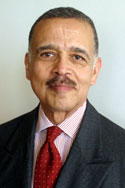ARCHIVES
OF EDITORIALS
June 3, 2004
The income gap
Just before his assassination in 1968, Martin Luther
King, Jr. had begun to organize the "Poor People’s
Campaign." After the Civil Rights Act was passed in 1964,
Dr. King realized that the most pressing issue facing America
was the plight of the poor. Unfortunately, that still remains
the case today.
For most fair-minded people it is unacceptable to have a large
number of poor people in the United States, the world’s
most highly developed economy. Those who would have us be insensitive
to the plight of the poor insist that the poor are simply reaping
the consequences of their sloth or the bad decisions they have
made in this, the land of opportunity.
However, many of the poor work very hard. A recent report indicates
that one of every four workers earns $18,800 a year or less, and
few have any job benefits. That income marks the federal poverty
line for a family of four. Those concerned with the welfare of
African Americans will be distressed to learn that 14 percent
of the working poor are black. But that fact by no means makes
this a special race issue.
More than 28 million people between the ages of 18 and 64 earn
less than $9.04 an hour. On a full-time basis, this would come
to $18,800 a year. While 14 percent of this group is African American,
58 percent are white and 22 percent are Latino. Some of these
wage earners avoid poverty because they are young and live at
home; others may have spouses who earn enough to lift their families
from the poverty category.
Nonetheless, escaping the blight of poverty does not greatly increase
the chances that the family will be living on easy street. The
average household income for families in the third quintile from
the bottom is $42,802. Forty percent of all households average
substantially less than that level of income. And it usually takes
the income of more than one family member to attain the higher
levels of income.
The Boston organization United for a Fair Economy has issued a
report recently to point out the growing income disparity in the
United States. The CEOs of major companies are now paid 301 times
the pay of the average worker. The average CEO gets $155,769 a
week compared to $517 for the average worker.
This disparity has grown enormously since 1982. Then CEOs earned
only 42 times the pay of the average worker. Since 1990 the pay
of the average worker has increased only 8 percent more than the
rate of inflation — 49 percent to 41 percent. However, the
pay of CEOs rose 313 percent.
One solution to the problem is to raise the minimum wage from
$5.15 an hour to $7.00 as proposed by Sen. Edward Kennedy. When
adjusted for inflation, the present minimum wage is 30 percent
less than it was in 1968.
Another solution is to raise federal Pell Grants for education.
In 1972, Pell Grants covered 84 percent of college tuition. Today
they pay for less than 40 percent. College education, even in
state colleges, is out of reach for many students from poor families
who want to increase their opportunities through education.
Of course there are a number of other problems such as Medicaid,
day care, Social Security and job training which must be resolved.
All of the solutions are political in nature. Unfortunately, only
about 40 percent of low-income Americans vote, compared to 74
percent of the affluent. Dr. Martin Luther King recognized that
a coalition of the poor when motivated could change the political
landscape.
It is imperative that black leaders deracinate the war on poverty
so that everyone, regardless of race, feels welcome to participate.
The political benefits to be achieved will fall equally on everyone,
just like the warming rays of the sun.
Home
Page

